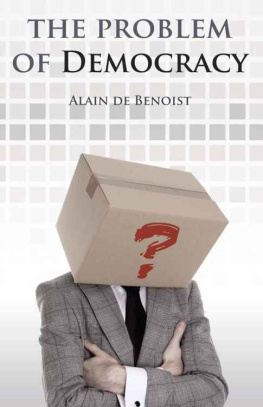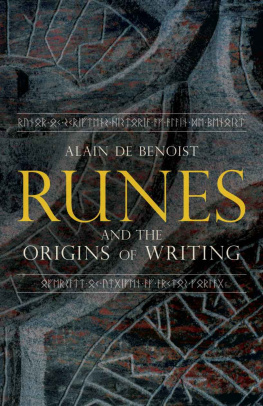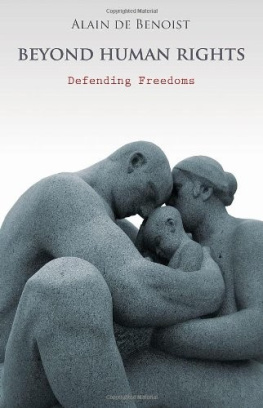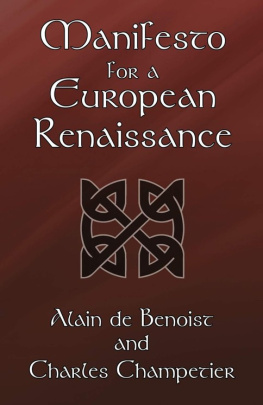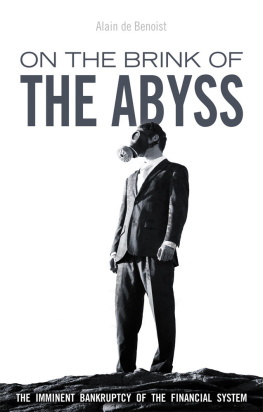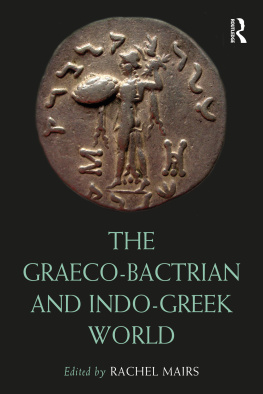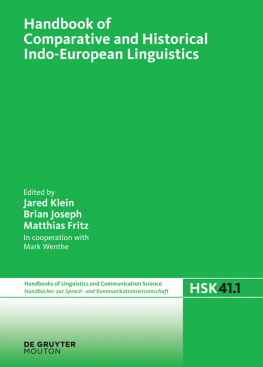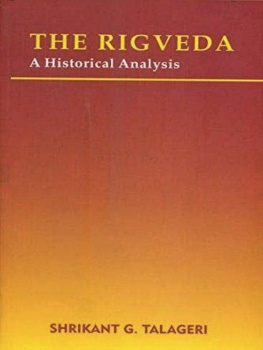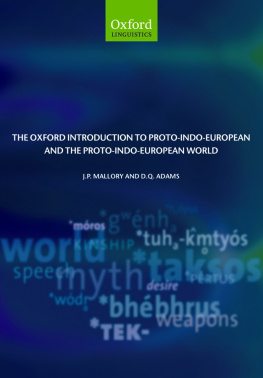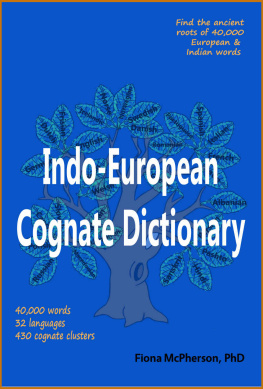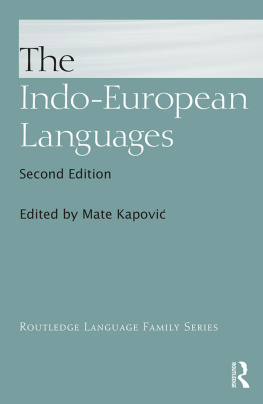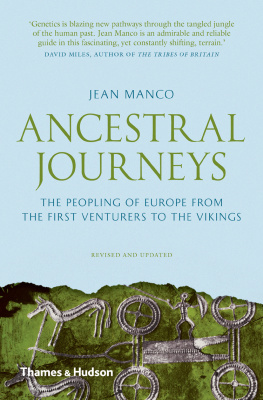Alain de Benoist
The Indo-Europeans: In Search of the Homeland
Translated by Aaron Cheak, PhD
Copyright 2016 by Arktos Media Ltd.
All rights reserved. No part of this book may be reproduced or utilised in any form or by any means (whether electronic or mechanical), including photocopying, recording or by any information storage and retrieval system, without permission in writing from the publisher.
www.arktos.com
Other books published by Arktos
Arktos on Facebook
ISBN
978-1-910524-86-2 (Softcover)
978-1-910524-87-9 (Hardback)
978-1-910524-91-6 (E-book)
BIC-CLASSIFICATION
Indo-European Languages (2A)
Prehistoric archaeology (HDDA)
Historical and comparative linguistics (CFF)
EDITOR
John B Morgan
TRANSLATION
Aaron Cheak
COVER DESIGN
Andreas Nilsson
LAYOUT
Tor Westman
A Note from the Editor
Unless otherwise indicated, the footnotes to the text were added by the author himself in the original French edition. Additional footnotes which were added by me or the translator for this edition for clarification are marked with either an Ed. or Tr.. Where sources in other languages have been cited, I have attempted to replace them with their equivalent English-language editions when they could be located. Citations to works for which I could locate no translation are retained in their original language.
J OHN B M ORGAN
Budapest, Hungary
15 July 2016
Translators Preface
Originally published in 1966 as Les Indo-Europens (GED), Alain de Benoists text appeared in a revised and expanded edition in 1997 as Indo-Europens: la recherche du foyer dorigine (Nouvelle cole). The present translation derives from the text of the 1997 edition. The most literal translation of the title is Indo-Europeans: In Search of the Original Homeland. However, we have followed Benoist himself, who in the text gives homeland (rather than original homeland) as the English equivalent of foyer originel. Cohering with standard use in Indo-European studies, the numerous appearances of foyer dorigine and foyer original (cf. German Urheimat) throughout the text have also been rendered as homeland for concision and impact.
Throughout this work, Benoist references a wealth of scholarly literature from Indo-European studies and related disciplines, such as archaeology, anthropology, and comparative religions. In addition to French authors, he cites primarily from German and English scholarship. Very frequently, studies originally written in English appear in French translation when quoted in Benoists text. In those cases where it was not possible to source Benoists original citations in the original English, what is presented in this translation, therefore, is a faithful representation in English of the quotations as given in French in Benoists text. Full citations are given by Benoist throughout for those who wish to follow up the original language references. Titles of works in foreign languages that appear in the main body of the work have been presented in their original languages, per Benoists original text, and glossed in English for the convenience of the reader.
A ARON C HEAK , PhD
The Indo-Europeans: In Search of the Homeland
Although foreseen at the end of the sixteenth century, notably by Leibniz
The ideas of Jones were popularised by Friedrich von Schlegel (18321915).
Shortly thereafter, while Kaspar Zeuss (Die Deutschen und die Nachbarstmme, 1837) was published in Strasbourg from 1886.
IE studies, the further history of which will not be traced here, has continued to grow. It remains above all the purview of linguistics, but also appeals to archaeology, anthropology, comparative mythology, ancient history, the history of religions, sociolinguistics, and so forth. On the archaeological map, the intensive excavations which have been undertaken since 1945, notably in Russia and in the Balkans, have allowed for better knowledge of prehistoric cultures and population movements between the fifth and the third millennia. On the linguistic map, the in-depth study of the diachronic evolution of certain terms has allowed their original meaning to be definitively established. Finally, the rise and development of comparative mythology has allowed the correlation between social structure and the internal hierarchy of the principal pantheons to be illuminated. The names of Marija Gimbutas, mile Benveniste, and Georges Dumzilto mention but a fewsymbolise these new approaches.
Proto-Indo-European: A Linguistic Fact
The fact of IE is universally recognised today. The Indo-European hypothesis has been proven beyond all possible doubt, remarks Paul Thieme. qualified as ante-history). All have evolved down to the present day, and continue to evolve. And of course, all bear cultural innovations in the domain of vocabulary and grammar; innovations, however, which obey mechanical constraints orienting them in foreseeable directions. Generally, the IE languages tend to lose their synthetic character over the course of history (complex conjugations, absence or weak use of the article, extremely rich declensions) in order to become more and more analytic (simplification of conjugations, more frequent use of the article and prepositions, impoverishment or disappearance of declensions).
The innumerable homologies and systematic resemblances, as well as lexical, syntactical, or grammatical similitudes that one finds among the IE languages cannot be explained by mere chance or exclusively by loans or sustained contacts. They unite strongly in favour of a common origin. Indeed, the hypothesis of the community of origin is what makes the best sense of the concordances that we find among the linguistic realties characterising languages spoken over an immense territory, ranging from Ireland to Chinese Turkestan. To say that there is a kinship among IE languages therefore means that if we go back far enough in time, we will find a single primary language from which they all originate, directly or indirectly. This language is called common or Proto-Indo-European (PIE). In a certain sense, Greek, Latin, Germanic, and so on, are simply PIE transformed.
In the strict sense, the term PIE applies only to phonetic, morphological, or lexical protoforms, or even to syntagms, that linguistic palaeontology has been able to reconstruct. By extension, the word designates the language as a whole spoken by the common IE at this stage. The work of linguists has shown that PIE possesses a grammar and a syntax at once complex and relatively homogenous, which prevents it being considered as a mixed language of the creole or pidgin variety. Like the Hamito-Semitic languages, it is a consonantal and inflectional language, in which the lexical sense is expressed by the consonants, whereas the vowels characterise the formation of the inflection: the words generally include an ending indicating their function in the phrase, the nouns and pronouns decline, the verbs conjugate, and so forth. At the last common stage, the verbal system comprised three voices (active, mediopassive, passive), five moods (indicative, subjunctive, imperative, optative, injunctive), and six tenses (present, imperfect, perfect, pluperfect, future, aorist). The inflection includes three numbers (singular, dual, plural), three genders (masculine, feminine, neuter), and eight cases in the inflection of animate gender. Around 4,000 words have been reconstructed to this day.
To explain the formation of the different IE languages, the German philologist August Schleicher (18211868), in his 1861
Next page

